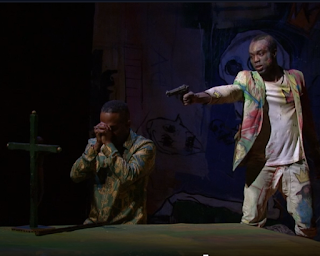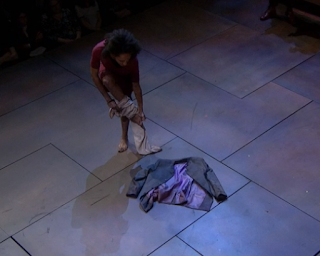Trust Is A Rare Commodity: Thoughts on the Entrance Examination
The second section of this year's 'entrance' exam question on Hamlet was a traditional essay question and asked:
(b) ‘In the world of Hamlet trust is a rare commodity.’
Using your knowledge of the play’s opening scenes, show how far you agree with this view.
Remember to support your answer with reference to different interpretations.
The first thing you need to do is form a hypothesis which engages with the statement that ‘In the world of Hamlet trust is a rare commodity.’ Is trust rare? Who trusts whom? Who doesn't? What happens at the start of the play to set this up? What kind of overarching idea do you have? But it is also worth thinking about 'trust' in more hopeful terms. Where are the moments and relationships of trust? Could this actually form the thrust of your argument? Or at least some kind of 'counter' to a bland acceptance of the statement. Horatio's presentation as a trustworthy character, reinforced by the ending? The strong allegiance between Claudius and Polonius?
There is certainly a great deal of spying and background machination in the first part of the play - much of it directed at or around Hamlet. As you saw from answering part a), Hamlet's first moments on stage are dominated by discord and establish his distrust of both Claudius and Gertrude. Once the Ghost has reappeared towards the end of act one and demanded a course of revenge, Hamlet's distrust is fully ignited. Beyond this, there are all sorts of things that you might also pick out to explore: Polonius employing Reynaldo to 'spy' on Laertes, Polonius and the 'set up' of Ophelia, the role of Rosencrantz and Guildenstern, Hamlet's 'antic disposition' and the play within a play to 'catch the conscience' of the king - and many more. Which will you pick ? It's difficult to tackle them all in depth during the short space of time you have.
But even more than that, Shakespeare's dramaturgy from the opening scene serves to create an atmosphere of mistrust, so it is probably worth exploring I.i in some detail - as some of you did very effectively. One character is on edge, very jumpy and ‘sick at heart’. Great tension is created and questions remain unanswered. ‘Who’s there?’ is repeated. The darkness is well established as the actors continually ‘act’ darkness. The fact that it is cloudy, murky and that something is wrong is signalled repeatedly. Together, the language and action establish a tone of suspicion, wariness and misgiving. Shakespeare's original audience were more susceptible to ghostly things than their more sceptical contemporary counterparts. Bernardo and Fransisco contrast with Horatio, reflecting the complexity of the audience makeup and their different intellectual viewpoints. Horatio is initially dismissive, and the ‘sit down awhile’ invitation creates a pantomime-esque ‘he's behind you’ staging dynamic. ‘Yond’ as a proposition encourages a theatrical sleight of hand, so that the audience are looking (perhaps) in a different direction to allow the ghost to enter. Even the audience don't know where to look and what to trust! During Horatio's speech a cock crows, signalling a betrayal in biblical terms (when Peter denies Jesus) as well as time passing towards dawn. The coming of the light also means enlightenment for the audience. It is established that the person to find out is Hamlet. He will be the one to unlock the secret of the dead king, albeit with tragic consequences.
This thinking, selecting and planning part of the process of responding will take up a great deal of time. Once those decisions have been made and you've selected which ideas are going to make up the main body of your response, you also need to give some consideration to which assessment objectives are dominant in this part of the exam. AO1 and AO5 are equally weighted for this section at 50%. The mark scheme for top band work says:
More on critical perspectives to come soon.
(b) ‘In the world of Hamlet trust is a rare commodity.’
Using your knowledge of the play’s opening scenes, show how far you agree with this view.
Remember to support your answer with reference to different interpretations.
The first thing you need to do is form a hypothesis which engages with the statement that ‘In the world of Hamlet trust is a rare commodity.’ Is trust rare? Who trusts whom? Who doesn't? What happens at the start of the play to set this up? What kind of overarching idea do you have? But it is also worth thinking about 'trust' in more hopeful terms. Where are the moments and relationships of trust? Could this actually form the thrust of your argument? Or at least some kind of 'counter' to a bland acceptance of the statement. Horatio's presentation as a trustworthy character, reinforced by the ending? The strong allegiance between Claudius and Polonius?
There is certainly a great deal of spying and background machination in the first part of the play - much of it directed at or around Hamlet. As you saw from answering part a), Hamlet's first moments on stage are dominated by discord and establish his distrust of both Claudius and Gertrude. Once the Ghost has reappeared towards the end of act one and demanded a course of revenge, Hamlet's distrust is fully ignited. Beyond this, there are all sorts of things that you might also pick out to explore: Polonius employing Reynaldo to 'spy' on Laertes, Polonius and the 'set up' of Ophelia, the role of Rosencrantz and Guildenstern, Hamlet's 'antic disposition' and the play within a play to 'catch the conscience' of the king - and many more. Which will you pick ? It's difficult to tackle them all in depth during the short space of time you have.
But even more than that, Shakespeare's dramaturgy from the opening scene serves to create an atmosphere of mistrust, so it is probably worth exploring I.i in some detail - as some of you did very effectively. One character is on edge, very jumpy and ‘sick at heart’. Great tension is created and questions remain unanswered. ‘Who’s there?’ is repeated. The darkness is well established as the actors continually ‘act’ darkness. The fact that it is cloudy, murky and that something is wrong is signalled repeatedly. Together, the language and action establish a tone of suspicion, wariness and misgiving. Shakespeare's original audience were more susceptible to ghostly things than their more sceptical contemporary counterparts. Bernardo and Fransisco contrast with Horatio, reflecting the complexity of the audience makeup and their different intellectual viewpoints. Horatio is initially dismissive, and the ‘sit down awhile’ invitation creates a pantomime-esque ‘he's behind you’ staging dynamic. ‘Yond’ as a proposition encourages a theatrical sleight of hand, so that the audience are looking (perhaps) in a different direction to allow the ghost to enter. Even the audience don't know where to look and what to trust! During Horatio's speech a cock crows, signalling a betrayal in biblical terms (when Peter denies Jesus) as well as time passing towards dawn. The coming of the light also means enlightenment for the audience. It is established that the person to find out is Hamlet. He will be the one to unlock the secret of the dead king, albeit with tragic consequences.
This thinking, selecting and planning part of the process of responding will take up a great deal of time. Once those decisions have been made and you've selected which ideas are going to make up the main body of your response, you also need to give some consideration to which assessment objectives are dominant in this part of the exam. AO1 and AO5 are equally weighted for this section at 50%. The mark scheme for top band work says:
- Excellent and consistently detailed understanding of text and question with consistently well-structured, coherent and detailed argument consistently developed.
- Consistently fluent and accurate writing in appropriate register with critical concepts and terminology used accurately.
- Judgement consistently informed by exploration of different interpretations of the text.
- Judgement consistently informed by changing critical views of the text over time.
There are some great exemplars here.
More on critical perspectives to come soon.



Comments
Post a Comment